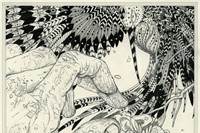A studio visit with artist Ernesto Caivano and exclusive previews of his upcoming LA exhibition.
In 2004, Ernesto Caivano burst onto the international art scene with After the Woods, his deeply thought, masterfully rendered ink drawings of an intricately layered imaginary world, one in which he depicted an ongoing evolution between nature and technology as told through an ageless love story between a man and a woman. The works combined myth, science, folklore, philosophy, fairytale, geometry, archaeology, medieval and renaissance literature, alchemy, and, of course, love, longing, and separation – both from the other and from the self. In a show at P.S. 1 and through his appearance in the Whitney Biennial that same year, critics swooned over Caivano’s formalist sense of beauty, his expert line and composition, his introduction of an elaborate narrative into a visual body of work, and his deft if unusual marriage of post-modern high-jinx and antiquated erudition. It was as if Umberto Eco had suddenly stopped writing novels and began drawing them instead.
Recently, I visited Ernesto at his Chinatown studio on Eldridge as he was finishing up work for two gallery exhibitions, one a group show in Madrid at Travesia Cuatro that just opened, the other a solo show at Richard Heller Gallery in Los Angeles that will open March 20. The images accompanying this column are exclusive previews of new work that will debut in Los Angeles.
On the street as I enter his building, there’s the usual frenetic Chinatown activity and accompanying din: produce sellers, kids clamouring for fresh dumplings at the shop next door, and a bunch of old men slapping down mahjong tiles in a nearby storefront — but upstairs, on the sixth floor, as Caivano opens his studio door, there’s a refuge of silence and calm. Caivano himself is relaxed and soft-spoken. Familiar with his work and the ambitious story behind it, I had imagined a man with hyper-kinetic, even protean energies. But what I realise upon entering the studio is Caivano is someone who cultivates his energies by establishing a purity of environment, an almost monastic peacefulness. There are plants in the windowsill where a diffuse light streams in. NPR plays on the radio in a low but audible volume. Against the far side of the studio, separated by a dry-wall divider, there is a wall of books. In the middle of the adjoining space sits an oversized drafting table where Ernesto does his work. Upon it are a number of drawings in pencil with familiar Caivano motifs — works in progress. These are just at the point where I’ll start adding ink and colour, he says.
For the next hour or so we talk about his work, the continuation of themes earlier explored and new ones that are preoccupying him now. Always at the centre is a deep reflection on systems — ecological and scientific — and the relationship between nature and technology, past and future, older forms of knowledge and love and how they might shape the world, or be shaped by it, as we progress. At one point in our conversation, Ernesto draws a parallel between the chivalrous knights of the Middle Ages and astronauts. There are a lot of similarities between the two, he says. There is the quest, and the protective uniform shielding the body. As he speaks, I start to think of him as a kind of astro-knight himself, exploring worlds, cosmos, and inter-linking systems, partly real and partly of his own imagining. The result of his explorations, it seems, is an understanding that we don’t just live in a world but in a universe of worlds, whose scope and subtlety we can never fully apprehend. As evening falls, I leave Ernesto Caivano to continue his quest through art — and to finish the work on his drafting table for his show in Los Angeles.
Derek Peck is a New York-based writer, photographer, and the editor and creative director of PLANET Magazine






